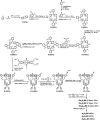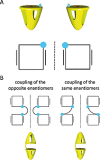Double Porphyrin Cage Compounds
- PMID: 33380897
- PMCID: PMC7756431
- DOI: 10.1002/ejoc.202001211
Double Porphyrin Cage Compounds
Abstract
The synthesis and characterization of double porphyrin cage compounds are described. They consist of two porphyrins that are each attached to a diphenylglycoluril-based clip molecule via four ethyleneoxy spacers, and are linked together by a single alkyl chain using "click"-chemistry. Following a newly developed multistep synthesis procedure we report three of these double porphyrin cages, linked by spacers of different lengths, i.e. 3, 5, and 11 carbon atoms. The structures of the double porphyrin cages were fully characterized by NMR, which revealed that they consist of mixtures of two diastereoisomers. Their zinc derivatives are capable of forming sandwich-like complexes with the ditopic ligand 1,4-diazabicyclo[2,2,2]octane (dabco).
Keywords: Axial ligands; Host–guest chemistry; Porphyrin compounds.
© 2020 The Authors. European Journal of Organic Chemistry published by Wiley‐VCH GmbH.
Figures










References
-
- Johnson A. and O'Donnell M., Annu. Rev. Biochem, 2005, 74, 283–315. - PubMed
-
- a) Elemans J. A. A. W., Bijsterveld E. J. A., Rowan A. E. and Nolte R. J. M., Chem. Commun, 2000, 2443–2444;
- b) Elemans J. A. A. W., Bijsterveld E. J. A., Rowan A. E. and Nolte R. J. M., Eur. J. Org. Chem, 2007, 751–757.
-
- a) Thordarson P., Bijsterveld E. J. A., Rowan A. E. and Nolte R. J. M., Nature, 2003, 424, 915–918; - PubMed
- b) Bernar I., Rutjes F. P. J. T., Elemans J. A. A. W. and Nolte R. J. M., Catalysts, 2019, 9, 195;
- c) Monnereau C., Hidalgo Ramos P., Deutman A. B. C., Elemans J. A. A. W., Nolte R. J. M. and Rowan A. E., J. Am. Chem. Soc, 2010, 132, 1529–1531. - PubMed
-
- a) Martens S., Landuyt A., Espeel P., Devreese B., Dawyndt P. and Du Prez F., Nat. Commun, 2018, 9, 4451; - PMC - PubMed
- b) Szweda R., Tschopp M., Felix O., Decher G. and Lutz J.‐F., Angew. Chem. Int. Ed, 2018, 57, 15817–15821; - PubMed
- Angew. Chem, 2018, 130, 16043;
- c) Rutten M. G. T. A., Vaandrager F. W., Elemans J. A. A. W. and Nolte R. J. M., Nat. Rev. Chem, 2018, 2, 365–381.
LinkOut - more resources
Full Text Sources
